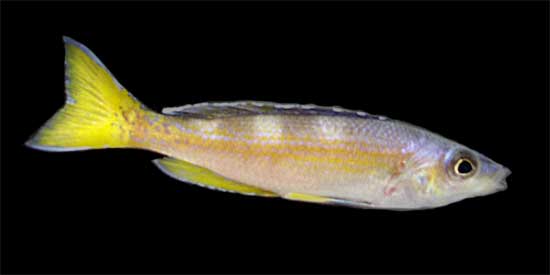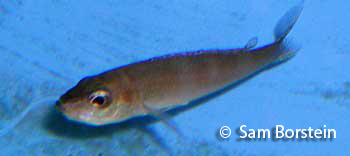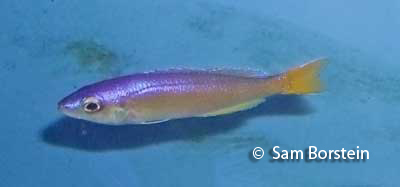Cyprichromis leptosoma
(Boulenger, 1898)
Sardine Cichlid

Above: A male Cyprichromis leptosoma "Kekese". Photo by Rick Borstein.
Etymology:
Genus- Cyprid= lovely (Latin), chromis= a fish, perhaps a perch (Greek).
Species- lepto=slender (Greek), soma= body (Greek).
Intro:
Although there are 6 fish (5 described, 1 undescribed), in the Cyprichromis genus, Cyprichromis leptosoma is one of the few readily available in the hobby. This maternal mouthbrooder is quite popular with Tanganyikan fans, as it is peaceful and relatively easy to keep. The only downside is that this fish is an expensive buy. This fish has many location variants and many locations have a wide variety of male coloration within the location. At some locations males with blue tails and males with yellow tails are found together (Konings, 1998).
Distribution:
The Sardine Cichlid is found on the eastern shore of Lake Tanganyika.
Size, Maturity, and Sexual Dimorphism:
Size: Males- 4 inches, Females- 3.5 inches
Maturity: 2 inches
Sexual Dimorphism: Males are larger and have color compared to the brown females.

Above: A holding female Cyprichromis leptosoma "Kekese". Photo by Sam Borstein.
Care:
Cyprichromis leptosoma is an easy species to care for. This fish does best in groups and in tanks with a high vertical column, as this fish is an open water swimmer. A group of 10 can easily be kept in a tank of 75 gallons. Make sure the tank is covered as these fish are jumpers.Diet:
In the wild, all Cyprichromis are open water plankton eaters, taking plankton from the water column (Konings, 1998). In aquaria, they can be picky eaters, but can and should be adapted to a flake or small pellet diet. This fish will appreciate a treat of brine shrimp and even baby brine shrimp.Breeding:
Sardine Cichlids are easy to breed if kept in an appropriate tank and given a year to reach sexual maturity. This fish is interesting because it is an open water spawner. Females will lay eggs in the water column, and the male will fertilize them and the female will then take them into her mouth from the water column.
The eggs of this fish are huge! While talking to Dr. Ron Coleman of Sacramento State University, he told me a type of Cyprichromis had the largest eggs he had ever measured for his Cichlid Egg Project. Because of the size of the eggs, the spawns are small. My largest out of 10 spawns was 9 eggs, which I considered to be a huge spawn.
Females are pretty good holders, but I still think this fish should be stripped. This though, can lead to problems because this fish has a delicate mouth. I found the best way to strip this fish is to put them in a turkey baster, and gently squeeze. This forces water through the gills of the female and pushes the eggs out of her mouth. Be careful not to push to hard as the fish can get stuck.
fry are huge, about 3/4 of an inch long when first free swimming! The fry for the first week stay at the surface of the water. I don't know why they exhibit this behavior. The fry are easy to raise on baby brine shrimp. It can be hard to get them to eat anything else because of their small mouths.

Above: A male Cyprichromis leptosoma "Kekese". Photo by Sam Borstein.
Conclusion:
Sardine Cichlids are cool fish. If you haven't kept them and are a Tanganyikan fan, give this fish a try. Do expect to pay some money though. Fry usually start at $8-$10 each. This fish is also a project, as it takes a while to get them to maturity.
References:
- Boulenger, G. A. (1898). Report on the fishes recently obtained by Mr. J. E. S. Moore in Lake Tanganyika. Proceedings of the Zoological Society of London, 494-497.
- Konings, A. (1998) Tanganyikan cichlids in their natural habitat. Cichlid Press, El Paso, Texas, 272 pp.
